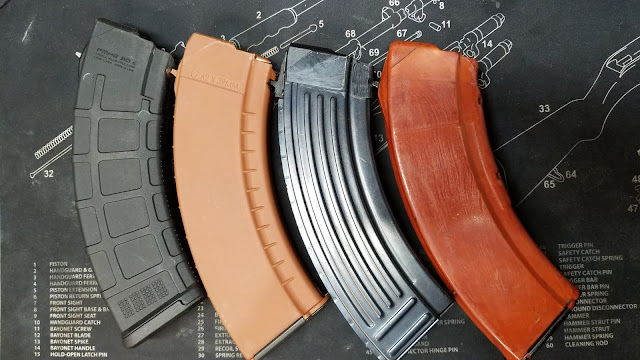AK Magazine Variants
Introduction:
AK mags come in all shapes and sizes. Even just in metal mags, you have slab side, two ribbed, three ribbed, and aluminum magazines, just to name a few. And after that, you have all the polymer and "Bakelite" variants. I'm just going to go into some detail on a couple of that mags that I happen to own and some of the interesting background surrounding them. I'll go over some of the interesting features that some of the mags have, as well as a little bit of history. I also won't just look at AKM magazines, I'll also take a look at the couple different mags I have for my SLR-106.
Details:
Steel Mags
The AK rifle does not normally feature a bolt hold-open common to other platforms seen in the West. This led to a brutally simple way of accomplishing the task. The Yugoslavians made a magazine with an extended follower that locks the bolt open after the last round is fired. The front of the bolt is just blocked from moving forward. Now, this is a much less elegant solution than a traditional bolt hold-open, since as soon as the magazine is removed, the bolt slams home. This simply functions as an indicator to let the shooter know they're out of ammo before they try and fire another round and just get a click.
Bakelites:
Another iconic AKM mag is know as the "Bakelite" mag. These are metal-reinforced magazines made out of a phenolic resin that isn't actually Bakelite. Real Bakelite was one of the first plastics, and does not have near the strength needed to stand up to the abuse of being an AK magazine. The mags are actually made out of a glass-reinforced polymer called AG-4S, and they are pretty durable and quite resistant to heat.
A the end of the day though, the magazines are still made out of a polymer and there are going to be rocked in and out of a metal receiver day in and day out, so the Russians were sure to account for this. They added metal reinforcement on the most high-traffic ares of the magazine, the locking surfaces. In the picture, you can see an original Russian magazine compared with a modern MagPul PMAG, with the metal reinforcement in the same place.
The Russians developed the Bakelite mag while looking for ways to reduce the weight carried by each individual soldier. Steel mags are heavy, so they originally tried using an aluminum magazine, similar to the US M16. This, however, did not end up working well. The magazines were found to be pretty fragile and the feed lips would easily deform. Once the AG-4S polymer was developed, it was found to fit the strength and weight requirements nicely.
Others:
AK magazines are a dime a dozen, and every country that has made an AK seems to have their own way of making magazines. Pictured are two 5.56 AK magazines from two different countries. The translucent green magazine is from Poland, and the black waffle pattern is Bulgarian. The Polish mag seems to be built to function and be cheap to manufacture. The mags have been extremely reliable and can take some moderate abuse, but the Bulgarian mags are built like tanks. While the Polish mags have an all-polymer construction, the Bulgarian mags seem to be made of a polymer with more fill material, and the mags themselves have a ton of metal reinforcing.
Here you can see the metal reinforcing present not only on the real locking lug, but also in the feed lips. These mages were my go-to in the rifle course I recently took, and sustained a whole lot of drops onto concrete. They never skipped a beat and have been 100% reliable both before and after. They're a very modern magazine design, incorporating filled polymers metals with polymer over-molding. Overall, I think you can tell that these are some of my favorite mags to use, because they just work and I don't need to worry about them.
Conclusion:
Magazines are one of those things that are often overlooked when it comes to firearms. We take for granted that they just work and throw them around, but there has been some serious engineering and iterative design that has gone into AK magazines over the decades. I feel that the 5.56 Bulgarian mag is a good example of this. Modern commercial PMAGs also take design ques from military designs like Bakelites, incorporating metal in just the right places to make everything durable.








Comments
Post a Comment